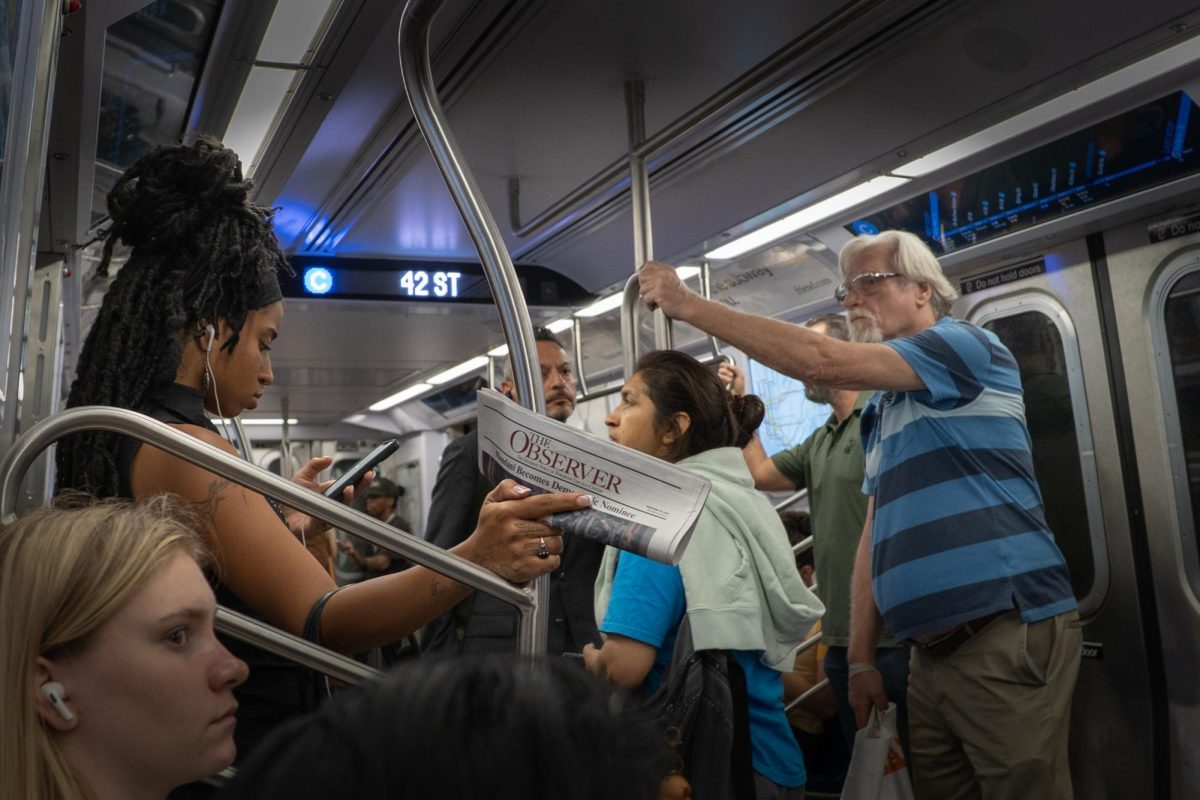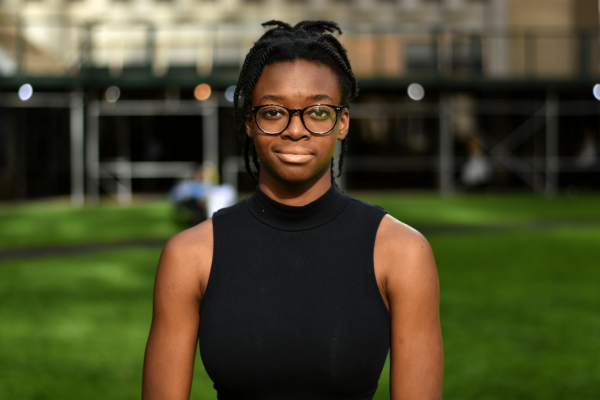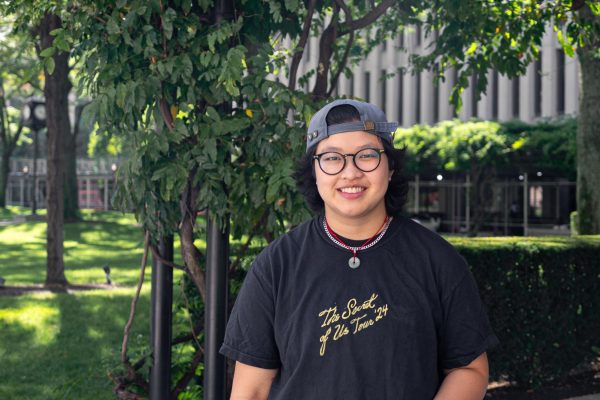Jeshua Daniel Jimenez is a native of the Bronx and a commuter student at Fordham. He starts his days around 7 a.m. He begins his 45-minute commute each morning by taking the 2 train to enter Manhattan and transfers to the 1 train at the 96th Street Station. He then gets off at 59th Street and Columbus Avenue, as many Fordham commuters do, and heads to his first class.
Jimenez, Fordham College at Lincoln Center (FCLC) ’28, is among the 40% of full-time commuter undergraduate students at the Fordham Lincoln Center campus. These students travel to campus, usually through the subway or on buses, racking up fare charges. If Jimenez were to take the subway twice, five days a week, at the current price of $2.90, he would spend $116 a month on transportation.
Additionally, this year on Sept. 30, the Metropolitan Transportation Authority (MTA) board approved an increase in transit fares, with the subway fares going from $2.90 to $3 and the MTA express bus from $7 to $7.25, officially in effect January 2026.
Mamdani is not alone; his opponents, Curtis Sliwa and Andrew Cuomo, have also recognized that affordability is the primary concern of this mayoral election cycle.
These fare increases impact transportation methods, making commuters’ lives more expensive as affordability is a concern for many. The New York City mayoral election is coming to a close as Election Day approaches on Nov. 4. Democratic Party nominee Zohran Mamdani is focused on affordability with his campaign. Mamdani is not alone; his opponents, Curtis Sliwa and Andrew Cuomo, have also recognized that affordability is the primary concern of this mayoral election cycle.
The Mamdani campaign has offered a multi-faceted approach to the issue of affordability in the city. The plan includes city-owned grocery stores, fare-free buses and rent freezes for rent-stabilized apartments.
In an interview for The Nation, Mamdani reiterated his commitment to his affordability plan.
“If they vote for me, they are voting for a rent freeze, they are voting for free buses, they are voting for universal childcare and city-run grocery stories with guaranteed lower prices,” Mamdani said. “That’s what I want to be held accountable to as soon as I am the mayor of New York City.”
Rival candidate Andrew Cuomo, the former governor of New York running on an independent party line, also touts affordability as a main concern. Cuomo’s campaign pledges to increase the supply of affordable housing, expand access to affordable healthcare and make transportation more affordable.
“New York City faces a crisis of affordability. Our City has always been expensive, but today it is rapidly becoming unaffordable for millions of hard-working New Yorkers at all income levels,” Cuomo’s campaign website states.
In order to provide more affordable housing, Sliwa pledges to change zoning laws, restore empty rent-controlled apartments and focus on small landlords.
Curtis Sliwa, the Republican candidate for mayor, has also included affordability as a priority for his campaign, alongside his primary platform on improving public safety. In order to provide more affordable housing, Sliwa pledges to change zoning laws, restore empty rent-controlled apartments and focus on small landlords. On his campaign website, he also proposes tax rebates for homeowners and “all NYC resident commuters, including public transit users and drivers impacted by congestion pricing.”
Sliwa will “focus on revitalizing existing spaces, supporting small landlords, and protecting middle-class families from being priced out of their own neighborhoods,” according to his campaign website.
With affordability on every New Yorker’s mind, many students are considering the economic viability of staying in a dorm versus commuting from home. Isabella Persaud, FCLC ’26, lives in a house with her parents in North Jersey and has a one-and-a-half-hour commute each morning.
“It was a really great experience to be on campus — being closer, not having to commute. I just found that it wasn’t worth the price of the dorm.” Isabella Persaud, FCLC ’26
Persaud commuted her first year, lived in McMahon Hall her sophomore year, and has commuted for the last two years.
“It was a really great experience to be on campus — being closer, not having to commute. I just found that it wasn’t worth the price of the dorm,” she said.
The MTA board met on Sept. 30 to approve increases to the MTA, Long Island Rail Road (LIRR) and Metro-North fares that will go into effect Jan. 1, 2026. The board also made adjustments to certain proposals to address public concerns about the new policies.
“The recent adjustments to some of the proposals further prioritize affordability and value for customers,” the MTA board stated.
“New Yorkers spend less on transportation than people in the rest of the country, and we’re determined to keep it that way.” Janno Lieber, MTA Board Chair and CEO
According to WABC-TV New York, on Jan. 1, 2026, there will be a 4.4% increase in the fares of the LIRR and Metro-North and a 10-cent increase to single-ride subway and bus tickets.
MTA Board Chair and CEO Janno Lieber defended the price changes in a press release published by the MTA.
“New Yorkers spend less on transportation than people in the rest of the country, and we’re determined to keep it that way,” Lieber said. “The modest fare increases approved today — which are below the rate of inflation — prioritize value for frequent riders and families while maintaining the MTA’s bottom line.”
Even though the MTA board voted 11-0 on the price increases, board members appointed from seven local counties, such as Dutchess County, are not celebrating the decision to raise prices for many of their constituents who travel to the city daily for work.
Melva M. Miller, a board member appointed by the governor, was conflicted about the fare hikes.
“I’m struggling with this decision,” Miller said. “For many New Yorkers that 10 cents might not sound like a lot, yet for someone balancing child care costs, rent, housing, all the other sorts of affordability, utilities and other rising costs living in New York City, that can drive them into impossible choices.”
Another commuter student, Leslie Grullon, Fordham Graduate School of Arts and Sciences ’25, is from the Bronx. She takes the subway to campus from her place of work and also noticed an increase in fare cost.
“I like to be able to leave law school at the end of the day. There’s a lot, it can get very taxing, and so it’s nice to have separation between church and state and be able to just leave at the end of the day … I like where I live.” Tabitha Franzetti, Fordham Law School ’28
“It used to be cheaper for sure,” she said, “I remember when it was $2.50, and I think now we are at $2.90.”
Tabitha Franzetti, Fordham Law School ’28, has lived in New York all her life and was an undergraduate at NYU. She has continued to live off-campus while attending law school at Fordham. To help her pay her rent at her apartment in Kips Bay, Franzetti has a 529 plan, an investment account meant for college savings. Although her plan will run out next year, Franzetti still finds it more financially beneficial to live in her apartment.
“I found that it’s a lot, in my opinion it’s cheaper to live off, I mean, at least at NYU, it was cheaper to live off campus,” she said.
Franzetti splits her rent of $3,600 with her freshman year roommate and wouldn’t trade it for campus life.
“I like to be able to leave law school at the end of the day,” she said, “There’s a lot, it can get very taxing, and so it’s nice to have separation between church and state and be able to just leave at the end of the day … I like where I live.”
Rent and transportation fees are a consistent cost for commuter students and New York City residents alike. Leading mayoral candidates Mamdani and Cuomo are aware of these financial burdens and have proposed plans to combat New Yorkers’ transportation burdens.
There was a free bus trial that ran across all five boroughs, specifically bus routes Bx18A/B, B60, M116, Q4 and S46/96 of NYC for a year from 2023 to 2024. The MTA shared the results of the trial, which showed only a slight increase in bus ridership.
Mamdani intends to implement a free bus plan that will eliminate fares for all bus routes in the five boroughs. He also intends to build more bus lanes to allow for a quicker ride, expand bus queue jump signals (specific traffic lights that give buses a head start at intersections) and dedicate loading zones to prevent double parking.
There was a free bus trial that ran across all five boroughs, specifically bus routes Bx18A/B, B60, M116, Q4 and S46/96 of NYC for a year from 2023 to 2024. The MTA shared the results of the trial, which showed only a slight increase in bus ridership. The MTA stated that its “foregone revenue and related costs amounted to more than $16.5 million in losses during the pilot period.” The buses also did not run faster — in fact, their average trip times slowed during the free fare trial. In the end, the trial showed mixed results of free fares for MTA buses.
Despite the varied outcomes of a fare-free bus system, Grullon believes it would be helpful with her transportation to Fordham.
“Tution here isn’t cheap,” Grullon said. “Having free transportation, I would say it would be a benefit for sure.”
Cuomo has also suggested that working toward more affordable transit for commuters in New York City is a step in the right direction. Cuomo’s plan would change guidelines to allow for more participation in the Fair Fares program. The Fair Fares program provides a 50% discount on subway and eligible bus fares for New York residents with low incomes. The Fair Fares website, nyc.gov/site/fairfares, contains more information on how to qualify for the program.
“I am financially supporting myself. But unfortunately, the government tends to see me as supported by my parents, even though I’m not.” Isabela Hill, FCLC ’26
Cuomo’s affordable transit plan received the support and endorsement of the Amalgamated Transit Union (ATU) Local 726 and the ATU of New York State Legislative Conference Board during a rally on Staten Island. ATU Local 726 represents Staten Island’s bus operators, mechanics and transit workers. Their goal is to maintain a fair, safe and smooth running transportation in the boroughs for both the riders and the workers. They opposed Mamdani’s plan for free buses because of its similarity to the failed $50 million failed free bus experiment that occurred in Kansas City in 2020, which ended in 2024. ATU stands with Cuomo in opposition to Mamdani’s plans.
Daniel Casella, president of the ATU Local 726 and chair of the ATU New York State Legislative Conference Board, spoke to The New York Post about the Cuomo plan. Casella supports his plan, as he sees Cuomo as a considerate candidate for the riders and workers of the transportation system.
“Cuomo has always recognized the unique challenges facing our borough’s transit system and is one of the rare elected officials to actually deliver for Staten Island riders and workers alike,” Cassella said.
With Cuomo’s plan to expand Fair Fares, commuter students would have the possibility of cheaper transportation fares; the only problem, for some students, is the eligibility requirements. This is the dilemma facing Fordham commuter student Isabela Hill, FCLC ’26, as she likes the idea of a discount but possibly wouldn’t qualify for the program.
“I am financially supporting myself,” she said. “But unfortunately, the government tends to see me as supported by my parents, even though I’m not.”
Hill lives independently of her parents in Brooklyn and pays rent on an apartment she shares with her boyfriend. They pay $1,600 a month.
For now, commuter students still have to pay for their transportation. Commuters often remain on campus because they do not have time to go back home between classes.
Jimenez stated he often stays on campus from 8:30 a.m. to 9 p.m. When asked if the lengthy commute and not being able to get home quickly was annoying or inconvenient, he was quick to answer.
“No,” Jimenez said. “I got used to it. It’s not bad,” he said.
Jimenez also stated that he plans to attend law school in the city, and living with his mom is the best option to plan for that.
“I want to go to law school, so I don’t want to have to take out loans to dorm or have my parents pay for dorming. Whereas if I can just commute and then save up for law school, it’s easier,” he said.
Jimenez said that in his senior year, he may move away from home-cooked Dominican dinners and get an apartment on his own, but right now, economically, staying at home is the best option.



